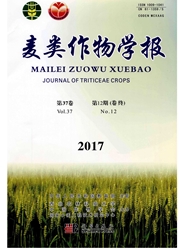

 中文摘要:
中文摘要:
为给野生二粒小麦资源利用提供依据,对分别来自以色列北部湿润山区的Mt.Hermon、北部加利利(Galilee)附近地区的Gamla、Ammiad和Tabigha、中部山地区的Mt.Gerizim以及南部内盖夫沙漠北缘的J’aba地区的6个自然群体野生二粒小麦种子的休眠与萌发特征进行了研究。结果表明,以色列野生二粒小麦成熟的种子均具有明显的休眠习性;高温(40℃)储藏可加快野生二粒小麦种子的后熟过程,从而可以迅速地打破种子的休眠;不同群体野生二粒小麦休眠的程度不相同,由深至浅其休眠顺序为:Mt.Gerizim〈Mt.Hermon〈J’aba〈Ammiad〈Tabigha〈Gamla。进一步的方差分析结果显示,同一小穗上,上、下部两粒种子的休眠和萌发特性也存在着极显著的差异。
 英文摘要:
英文摘要:
The dormancy and germination of Triticum dicoccoides caryopsis from six populations in Israel was investigated in this study. The results showed that wild emmer wheat, T. dicoccoides developed non-exogenous dormancy. The storage condition under high temperature at 40℃ could accelerate the afterripening process and break caryopsis dormancy of T. dicoccoides, and the order of dormancy depth among these six populations was Mr. Gerizim 〈 Mr. Hermon 〈 J'aba 〈 Ammiad 〈 Tabigha Gamla. A significant difference in dormancy between two seeds in the same spikelet was found. The present results demonstrated that evolutionary background had a strong effect on the intensity of caryopsis dormancy of wild emmer wheat, and T. dicoccoides populations have evolved adaptive mechanisms by regulating the time of germination in Israel. The obtained results also displayed that dormancy in wild emmer wheat could be used for genetic studies and improvement of modern wheat cultivars.
 同期刊论文项目
同期刊论文项目
 同项目期刊论文
同项目期刊论文
 Pathogen race determines the type of resistance response in the stripe rust- Triticum dicoccoides pa
Pathogen race determines the type of resistance response in the stripe rust- Triticum dicoccoides pa Phenotypic variation in caryopsis dormancy and seedling salt tolerance in wild barley, Hordeum spont
Phenotypic variation in caryopsis dormancy and seedling salt tolerance in wild barley, Hordeum spont 期刊信息
期刊信息
